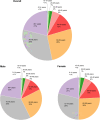Cancer treatment and survivorship statistics, 2025
- PMID: 40445120
- PMCID: PMC12223361
- DOI: 10.3322/caac.70011
Cancer treatment and survivorship statistics, 2025
Erratum in
-
Correction to "Cancer treatment and survivorship statistics, 2025".CA Cancer J Clin. 2025 Sep 13. doi: 10.3322/caac.70036. Online ahead of print. CA Cancer J Clin. 2025. PMID: 40944902 No abstract available.
Abstract
The number of people living with a history of cancer in the United States continues to rise because of the growth and aging of the population as well as improved survival through advances in early detection and treatment. To assist the public health community serve the needs of these survivors, the American Cancer Society and the National Cancer Institute collaborate triennially to estimate cancer prevalence in the United States using data from the Surveillance, Epidemiology, and End Results cancer registries, the Centers for Disease Control and Prevention's National Center for Health Statistics, and the United States Census Bureau. In addition, cancer treatment patterns are presented from the National Cancer Database along with a brief overview of treatment-related side effects. As of January 1, 2025, about 18.6 million people were living in the United States with a history of cancer, and this number is projected to exceed 22 million by 2035. The three most prevalent cancers are prostate (3,552,460), melanoma of the skin (816,580), and colorectum (729,550) among males and breast (4,305,570), uterine corpus (945,540), and thyroid (859,890) among females. About one half (51%) of survivors were diagnosed within the past 10 years, and nearly four fifths (79%) were aged 60 years and older. Racial differences in treatment in 2021 were common across disease stage; for example, Black people with stage I-II lung cancer were less likely to undergo surgery than their White counterparts (47% vs. 52%). Larger disparities exist for rectal cancer, for which 39% of Black people with stage I disease undergo proctectomy or proctocolectomy compared to 64% of their White counterparts. Targeted, multi-level efforts to expand access to high-quality care and survivorship resources are vital to reducing disparities and advancing support for all survivors of cancer.
Keywords: prevalence; statistics; survivorship; treatment patterns.
© 2025 The Author(s). CA: A Cancer Journal for Clinicians published by Wiley Periodicals LLC on behalf of American Cancer Society.
Conflict of interest statement
The authors gratefully acknowledge all cancer registries and their staff for their hard work and diligence in collecting cancer information, without which this research could not have been accomplished.
K. Robin Yabroff reports support for professional activities from Flatiron Health outside the submitted work. Patricia A. Ganz reports personal/consulting fees from Blue Note Therapeutics, Grail, Informed DNA, and Roche; and service on a Data and Safety Monitoring Board for Astellas Pharma and Duke University outside the submitted work. Nikita Sandeep Wagle, Leticia Nogueira, K. Robin Yabroff, Farhad Islami, Ahmedin Jemal, Rick Alteri, and Rebecca L. Siegel are employed by the American Cancer Society, which receives grants from private and corporate foundations, including foundations associated with companies in the health sector, for research outside of the submitted work. The authors are not funded by or key personnel for any of these grants, and their salary is solely funded through American Cancer Society funds. Other authors report no conflicts of interest.
Figures
















References
-
- Weaver KE, Forsythe LP, Reeve BB, et al. Mental and physical health‐related quality of life among U.S. cancer survivors: population estimates from the 2010 National Health Interview Survey. Cancer Epidemiol Biomarkers Prev. 2012;21(11):2108‐2117. doi: 10.1158/1055-9965.EPI-12-0740 - DOI - PMC - PubMed
MeSH terms
LinkOut - more resources
Full Text Sources
Medical
Research Materials
Miscellaneous

